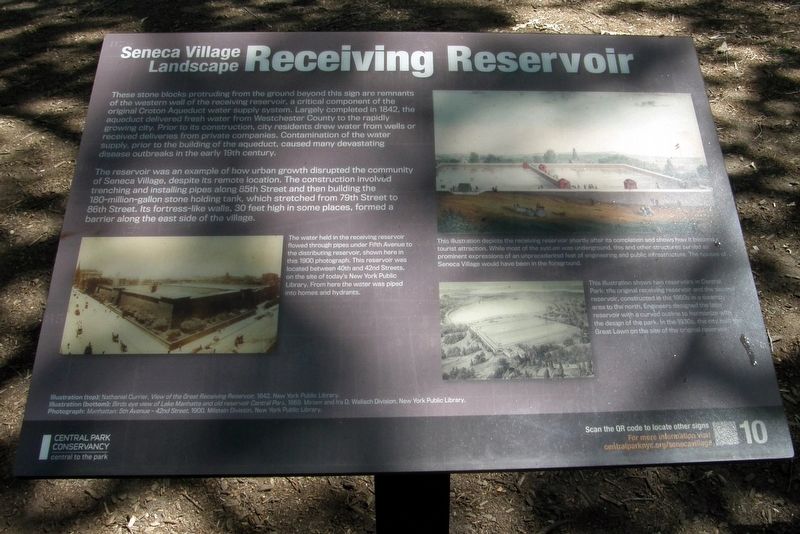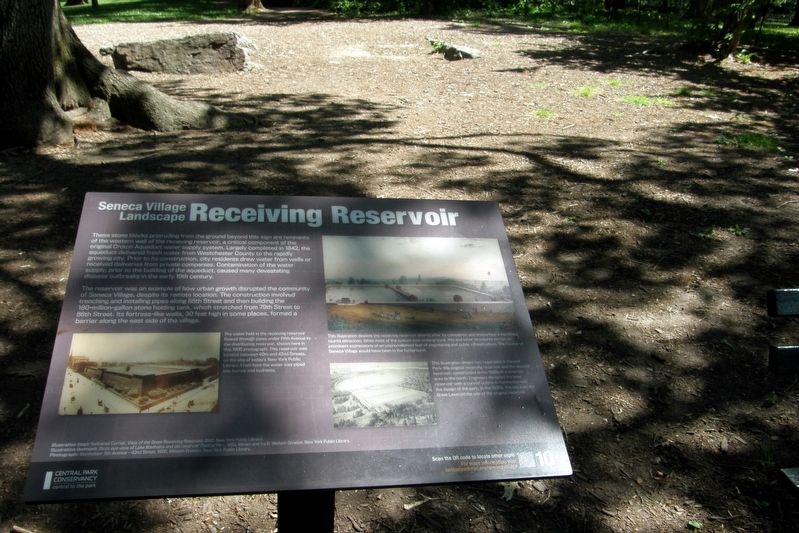Central Park West Historic District in Manhattan in New York County, New York — The American Northeast (Mid-Atlantic)
Receiving Reservoir
Seneca Village Landscape
These stone blocks protruding from the ground beyond this sign are remnants of the western wall of the receiving reservoir, a critical component of the original Croton Aqueduct water supply system. Largely completed in 1842, the aqueduct delivered fresh water from Westchester County to the rapidly growing city. Prior to its construction, city residents drew water from wells or received deliveries from private companies. Contamination of the water supply, prior to the building of the aqueduct, caused many devastating disease outbreaks in the early 19th century.
The reservoir was an example of how urban growth disrupted the community of Seneca Village, despite its remote location. The construction involved trenching and installing pipes along 85th Street and then building the 180-million-gallon stone holding tank, which stretched from 79th Street to 86th Street. Its fortress-like walls, 30 feet high in some places, formed a barrier along the east side of the village.
Erected 2020 by Central Park Conservancy. (Marker Number 10.)
Topics. This historical marker is listed in these topic lists: Parks & Recreational Areas • Settlements & Settlers. A significant historical year for this entry is 1842.
Location. 40° 46.839′ N, 73° 58.142′ W. Marker is in Manhattan, New York, in New York County. It is in the Central Park West Historic District. Marker is on West 81st Street east of Central Park West. Touch for map. Marker is at or near this postal address: Central Park, New York NY 10024, United States of America. Touch for directions.
Other nearby markers. At least 8 other markers are within walking distance of this marker. The Swedish Cottage Marionette Theatre (about 400 feet away, measured in a direct line); Belvedere Tower (about 500 feet away); Tanner’s Spring (about 600 feet away); Housing (about 700 feet away); Discover Seneca Village (about 800 feet away); Livelihoods (approx. 0.2 miles away); Lanes, Lots and Streets (approx. 0.2 miles away); King Wladyslaw Jagiello (approx. 0.2 miles away). Touch for a list and map of all markers in Manhattan.
Also see . . .
1. Seneca Village. Wikipedia entry (Submitted on April 28, 2021, by Larry Gertner of New York, New York.)
2. Seneca Village Site. Central Park Conservancy website entry:
Links to several related sub-topics (Submitted on April 28, 2021, by Larry Gertner of New York, New York.)
3. Seneca Village, New York City. National Park Service entry (Submitted on April 28, 2021, by Larry Gertner of New York, New York.)
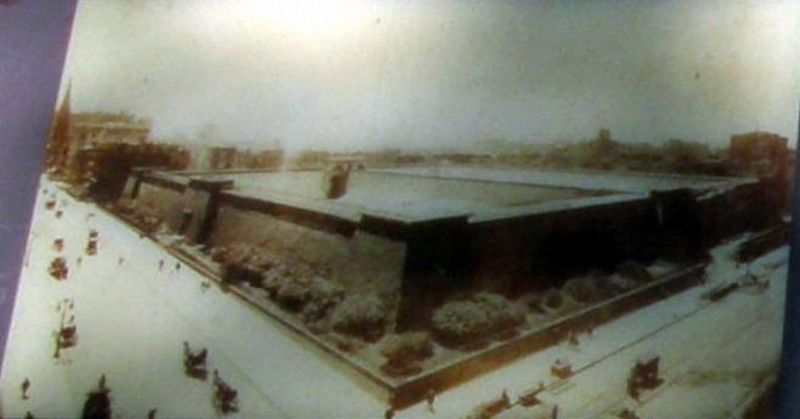
Photographed By Larry Gertner, June 17, 2020
3. Inset
The water held in the receiving reservoir flowed through pipes under Fifth Avenue to the distributing reservoir, shown here in this 1900 photograph. The reservoir was located between 40th and 42nd Streets, on the site of today’s New York Public Library. From here the water was piped into home and hydrants.
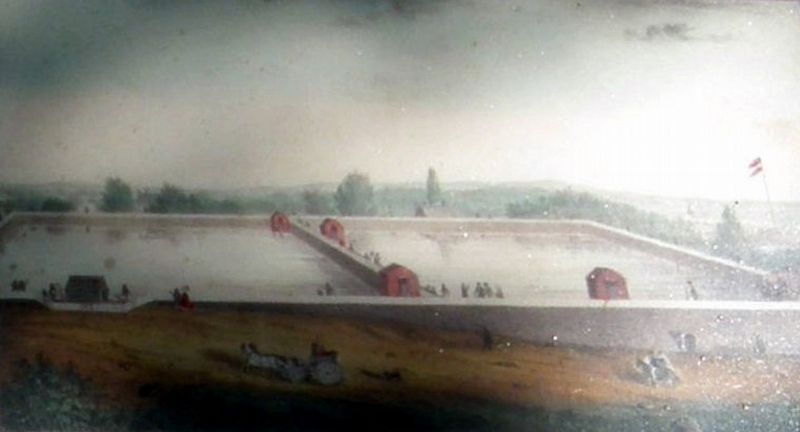
Photographed By Larry Gertner, June 17, 2020
4. Inset
This illustration depicts the receiving reservoir shortly after its completion and shows how it became a tourist attraction. While most of the system was underground, this and other structures served as prominent expressions of an unprecedented feat of engineering and public infrastructure. The houses of Seneca Village would have been in the foreground.
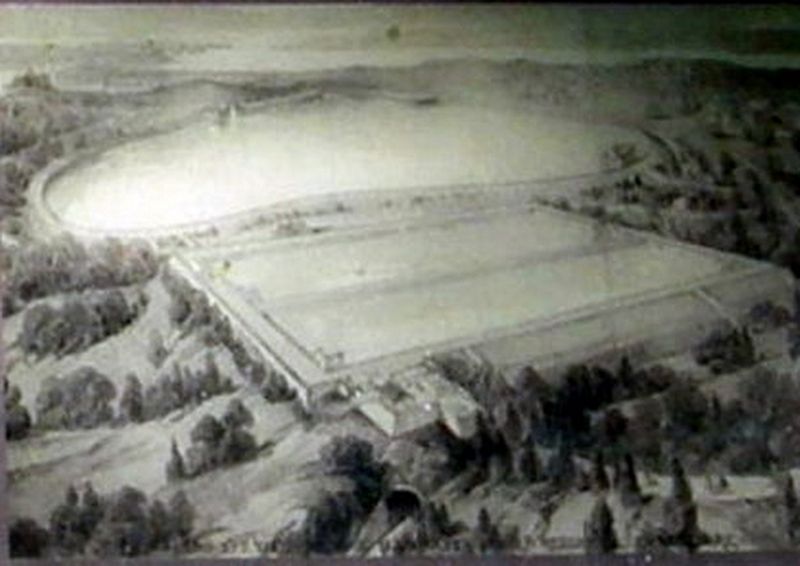
Photographed By Larry Gertner, June 17, 2020
5. Inset
This illustration shows two reservoirs in Central Park: the original receiving reservoir and the second reservoir, constructed in the 1860s in a swamp area to the north. Engineers designed the latter reservoir with a curved outline to harmonize with the design of the park. In the 1930s, the city built the Great Lawn on the site of the original reservoir.
Credits. This page was last revised on June 16, 2023. It was originally submitted on April 28, 2021, by Larry Gertner of New York, New York. This page has been viewed 151 times since then and 10 times this year. Photos: 1, 2, 3, 4, 5, 6. submitted on April 28, 2021, by Larry Gertner of New York, New York.
